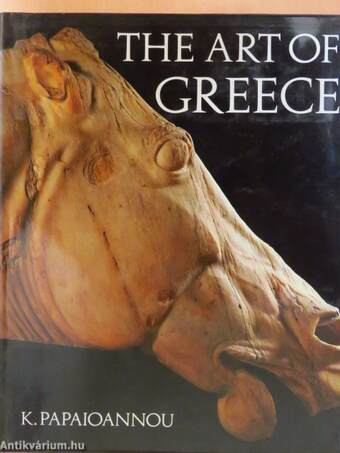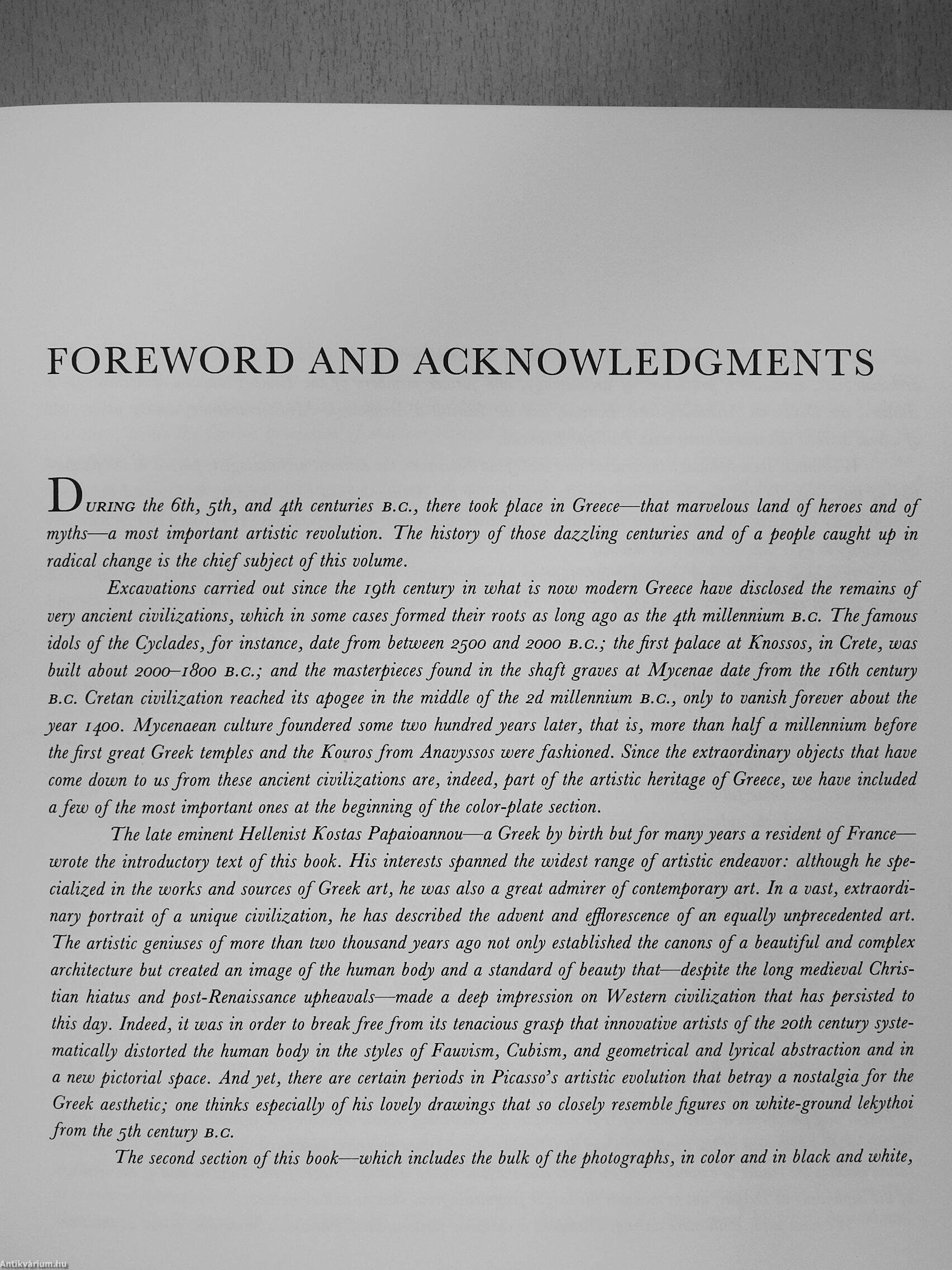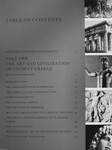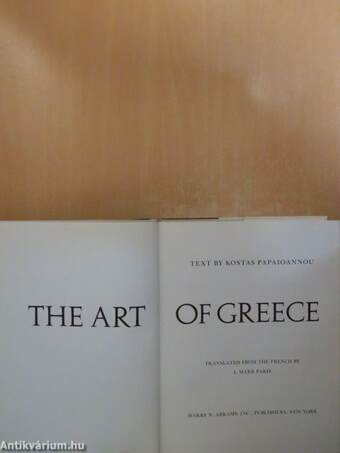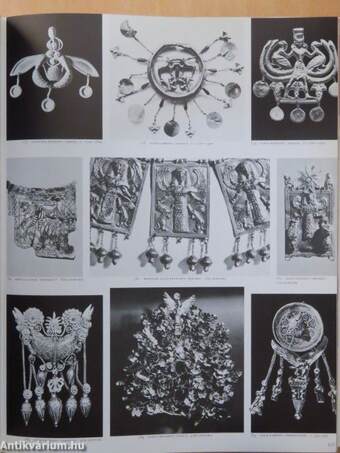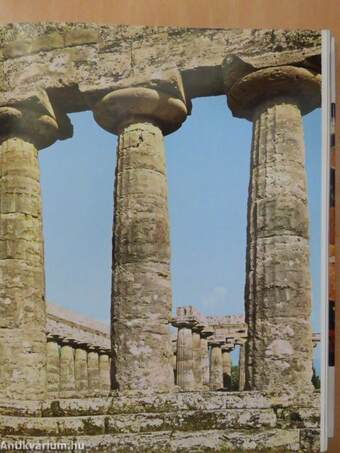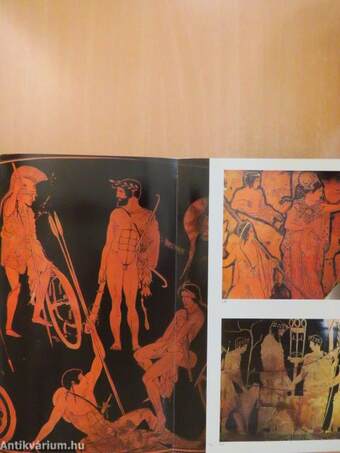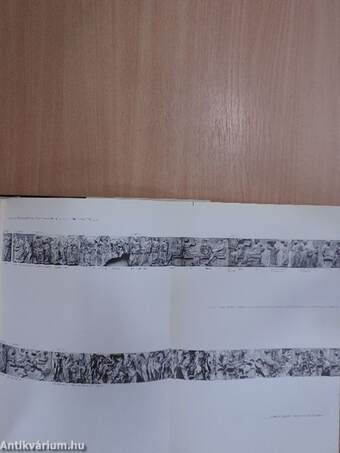1.115.241
kiadvánnyal nyújtjuk Magyarország legnagyobb antikvár könyv-kínálatát
The Art of Greece
| Kiadó: | Harry N. Abrams, Inc |
|---|---|
| Kiadás helye: | New York |
| Kiadás éve: | |
| Kötés típusa: | Vászon |
| Oldalszám: | 637 oldal |
| Sorozatcím: | |
| Kötetszám: | |
| Nyelv: | Angol |
| Méret: | 32 cm x 25 cm |
| ISBN: | 0-8109-0634-1 |
| Megjegyzés: | Színes és fekete-fehér fotókkal, kihajtható melléklettel. |
naponta értesítjük a beérkező friss
kiadványokról
naponta értesítjük a beérkező friss
kiadványokról
Előszó
TovábbFülszöveg
THE ART OF GREECE
Kostas Papaioannou
For 2,500 years the course of Western art has been guided by the legacy of the Greeks. Their astounding creative power and aesthetic vision are celebrated in this splendid survey of the architecture, sculpture, painting, and decorative arts of a civilization that measured its glory as much by the beauty of its monuments as by its great political and military achievements.
Drawing upon his vast knowledge of classical history, philology, literature, philosophy, and aesthetics, the eminent Hellenist Kostas Papaioannou explores the history and character of Greek civilization from the heroic age of the Mycenaeans to the triumph of Hellenism in the ecumenical empire of Alexander the Great. Within this broad cultural context, Papaioannou presents the principal aspects and developments of Greek art. Major stylistic innovations, key monuments, significant motifs and themes, and the activities of important artists are illuminated by his erudition and... Tovább
Fülszöveg
THE ART OF GREECE
Kostas Papaioannou
For 2,500 years the course of Western art has been guided by the legacy of the Greeks. Their astounding creative power and aesthetic vision are celebrated in this splendid survey of the architecture, sculpture, painting, and decorative arts of a civilization that measured its glory as much by the beauty of its monuments as by its great political and military achievements.
Drawing upon his vast knowledge of classical history, philology, literature, philosophy, and aesthetics, the eminent Hellenist Kostas Papaioannou explores the history and character of Greek civilization from the heroic age of the Mycenaeans to the triumph of Hellenism in the ecumenical empire of Alexander the Great. Within this broad cultural context, Papaioannou presents the principal aspects and developments of Greek art. Major stylistic innovations, key monuments, significant motifs and themes, and the activities of important artists are illuminated by his erudition and his historical imagination.
One of the most outstanding features of The Art of Greece is the section on the archaeological sites. The Greeks established colonies across the entire Mediterranean, encrusting the landscape with temples and cities like jewels in a crown. Beginning with Athens, more than eighty principal settlements from Spain to Asia Minor are described, and a wealth of photographs and plans accompanies these texts by experts in the field.
With its handsome design and 1,035 illustrations—161 of them in full color and many on lavish foldout pages—The Art of Greece is unsurpassed in coverage and visual beauty. One unprecedented feature is a photographic reconstruction of the entire Parthenon frieze. The famous sculptures have been scattered in museums around the world since the nineteenth century, and until now it has been impossible to view them as a unit and to admire their magnificent orchestration.
The Art of Greece contains invaluable reference materials, including an extensive political and military chronology; thumbnail biographies of key mythological figures, artists, philosophers, and writers; photographs of Roman copies of famous Greek statues long since destroyed; and a full bibliography.
There exist many books on Greece but none provides such a comprehensive, lavishly illustrated, and stimulating introduction to the greatest civilization of the ancient world.
1,035 illustrations, including 161 plates in full color, foldouts, ground plans, elevations, diagrams, drawings, and maps Vissza
Témakörök
- Idegennyelv > Idegennyelvű könyvek > Angol > Művészetek > Művészettörténet, általános
- Idegennyelv > Idegennyelvű könyvek > Angol > Művelődéstörténet
- Művelődéstörténet > Civilizációtörténet > Európai
- Művelődéstörténet > Kultúra > Története
- Művészetek > Művészettörténet általános > Kontinensek művészete > Európa
- Művészetek > Művészettörténet általános > Idegen nyelv > Angol
- Művészetek > Művészettörténet általános > Művészettörténet > Külföldi
- Művészetek > Művészettörténet általános > Korszakok, stílusok > Ókor > Görög
- Régészet > Általános régészet, antropológia > Ókor
- Idegennyelv > Idegennyelvű könyvek > Angol > Régészet > Általános régészet, antropológia > Ókor
- Idegennyelv > Idegennyelvű könyvek > Angol > Régészet > Kontinensek szerint > Európa
- Régészet > Kontinensek szerint > Európa > Egyéb
Kostas Papaioannou
Kostas Papaioannou műveinek az Antikvarium.hu-n kapható vagy előjegyezhető listáját itt tekintheti meg: Kostas Papaioannou könyvek, művekMegvásárolható példányok
Nincs megvásárolható példány
A könyv összes megrendelhető példánya elfogyott. Ha kívánja, előjegyezheti a könyvet, és amint a könyv egy újabb példánya elérhető lesz, értesítjük.


